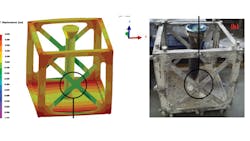R&D Advancing Simulation of Centrifugal Casting for Large Ti Structures
As an engineering material, titanium has much to offer: it is lightweight but strong, with the highest ratio of strength-to-mass of any metallic element; and yet it is corrosion-resistant, and adaptable via alloying to numerous applications. Defense and aerospace markets have been driving demand for titanium alloys and parts formed in titanium for the past few decades.
The main disadvantage of titanium is a considerable one for manufacturing, however: it is highly reactive, so many casting and fabricating processes must be performed in a vacuum or purged atmosphere.
Three years ago the European Commission authorized a research program — called the COLTS project (Casting of Large Titanium Structures) — linking European and Chinese industrial teams, to refine centrifugal and gravity casting techniques so that large Ti components might be manufactured cost-effectively.
Centrifugal casting is commonly used to produce thin-walled parts in high volumes, as would be expected for aerospace structural parts.
With the emphasis on cost-efficiency, the initial focus of the research involved skull melting of titanium, because it limits the superheat of the alloy (Ti6Al4V) to about 40°C above its melting point. Then, because of the relatively low temperature, centrifugal casting or gravity casting is indicated, for effective mold filling.
The cast designs under study are two different aerospace structures, 1.5 to 4 meters long.
Now, casting process simulation software developer ESI Group is due to release the results of its study into process modeling of centrifugal casting for large titanium structural components. ESI said the results would contribute to the further progress of the COLTS project.
Early Problem Prediction
“European projects significantly contribute to ESI’s research activity, enabling us to better support our clients in driving industrial innovation,” stated Ole Köser, who as manager of ESI’s Center of Excellence for Casting and Metallurgy is its team leader for COLTS.
The developer will present the complete study at the 71st World Foundry Congress, in Bilbao, Spain.
ESI’s project partners selected its casting simulation software to support the advanced centrifugal casting processes, which were specifically defined for thin-walled titanium structures.
To support this research effort, the casting simulation had to be capable of early prediction of potential problems like filling-related defects (inclusions, misruns, blowholes), porosity formed during solidification, and deformation during subsequent cooling. Further, this had to be done in such a way that the effect of process parameters (including filling time, filling temperature, mold pre-heating temperature, and mold rotation speed) could be readily assessed.
In the course of its research, ESI extended the capabilities of its ProCast casting simulation software. It noted that the efforts have improved the software’s fluid-flow solver to handle complex turbulent flow patterns, including the effect of the direction of the centrifugal force on porosity formation.
“The extended functionalities of ProCAST, gained through the COLTS project, will be invaluable at industrial level to set up cost-efficient centrifugal casting processes for titanium parts,” according to Dr. Rui Yang, director of China’s Institute of Metal Research, another participant in the COLTS project.
“Manufacturers using the software will gain a considerable amount of time and money, contributing to the production of better quality parts for aeronautical applications, both in Europe and in China,” Yang added.
About the Author
Robert Brooks
Content Director
Robert Brooks has been a business-to-business reporter, writer, editor, and columnist for more than 20 years, specializing in the primary metal and basic manufacturing industries. His work has covered a wide range of topics, including process technology, resource development, material selection, product design, workforce development, and industrial market strategies, among others.
